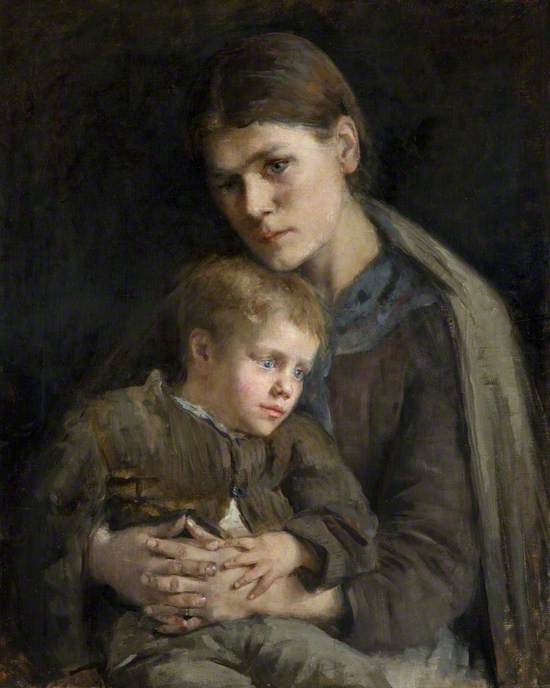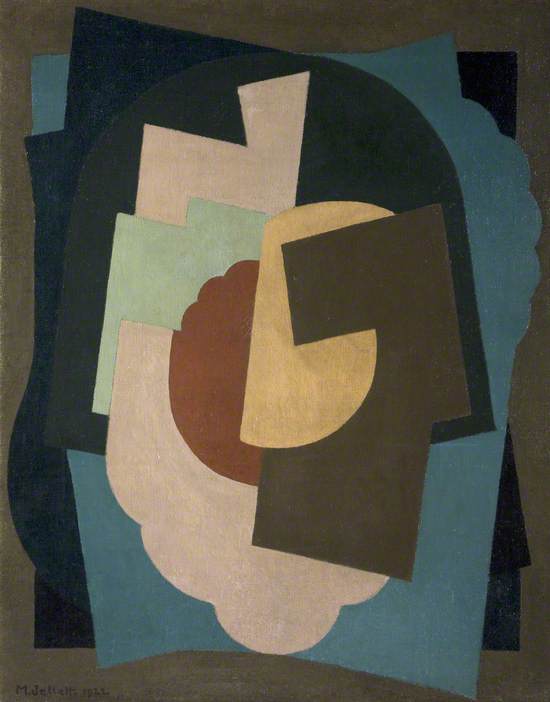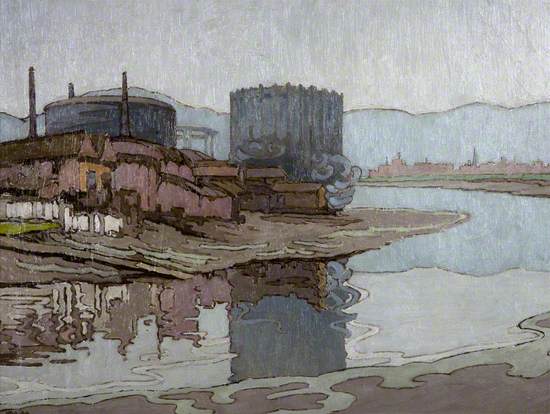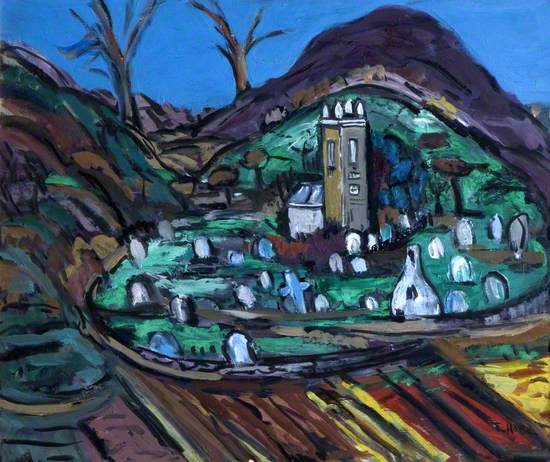Irish women are among some of the most interesting figures in today's art collections. They made strides in every area from portraiture to purely abstract works, but many were also organisers, teachers and activists. Yet, in comparison to their male counterparts, they have been historically under-collected and undervalued by museums and art galleries.
Within the mass digitisation of artworks and the advent of Women's History Month however, we can answer these oversights by spotlighting the Ulster Museum's collection of women artists from North and South of the border. This curation is not an attempt to sub-categorise them, but rather to celebrate a rich tapestry of artists who are at once interwoven and independent visionaries.
Sarah Henrietta Purser (1848-1943)
Purser was born in Dún Laoghaire, Co. Dublin in 1848 as the daughter of a flour miller and brewer. She was educated in Switzerland before moving to Dublin to study at the Metropolitan School of Art, where she soon became a prominent portraitist. She was made an honorary member of the Royal Hibernian Academy in 1890 and later became the first woman full member in 1924.
Purser's portraits were renowned for their extraordinary attention to detail and her ability to convey the inner emotional truths of her subjects. They were so popular, in fact, that Purser would later remark that she 'went through the British Aristocracy like the measles'. She also painted prominent Irish figures such as W.B Yeats, Jack Yeats and Roger Casement.
An Irish Idyll
An Irish Idyll is a departure from Purser's usual portraits of aristocrats, writers and political figures. This work shifts that foucs to an ordinary rural mother with her child in her lap. As per the title, the work focuses on a fleeting yet comfortable moment of rest from rural life.
The subjects of this work are extended the same attention to detail that Purser's other portraits had become famous for. Her use of light and shadow unveil the contrasting inner emotions of the two figures. While the child expresses a comfortable disposition, the mother is visibly saddened about what lies ahead after the brief idyll. The work exemplifies the movement of Purser's works; portraying lives beyond the painting as well as within it.
Sarah Henrietta Purser (1848–1943)
Oil on canvas
H 76.5 x W 64.7 cm
National Museums NI
Mainie Jellett (1897-1944)
Jellett was born in Dublin in 1897 as the daughter of a prominent lawyer. Her background afforded her a private art education from the age of 11, with Elizabeth Yeats and Sarah Cecilia Harrison being among her first teachers. She later studied at the Metropolitan School of Art, Dublin where she became heavily influenced by William Orpen. In the 1920s, she met her close friend Evie Hone in London and the two would go together to learn abstract and cubism techniques under Albert Gleizes in Paris.
Jellett is credited for trying her hand at many artistic movements, but primarily for bringing abstract art to Irish audiences. Scholars often ponder how much more influence she could have had if cancer had not cut her life tragically short in 1944.
Abstract
Abstract (1922) is remarkable mot only for its artistic expression, but also for its place in Irish Art History. While other European audiences had mostly embraced abstract concepts, works of this kind were truly shocking to Irish audiences.
This work was one of four pure abstracts exhibited in 1923 and was met with resistance at a time when Jack Yeat's expressionism was considered daring. The lack of tangibly identifiable subjects was immediately written off as merely eccentric. These attitudes did not soften until the 1930s.
The work exemplifies Jellett's favour of form, colour and movement over realism. These principles would also play a significant role in the artistic freedom seen in her works in nude and still life areas.
Georgina Moutray Kyle (1865-1950)
Kyle was born in Craigavad, Co. Down in 1865. Her father was a Scottish linen tradesman, who supplied materials to prominent figures such as Queen Victoria. Her sheltered childhood came to an abrupt halt when she went to study at the Académie Colarossi, Paris at just 18 years old.
She later became a member of the Belfast Art Society and first exhibited with them in 1894. She would be elected president of the organisation four times over the course of the 1920s. Her works would be shown in Ireland, Scotland, France and Belgium.
Kyle became well known for urban landscapes and busy scenes; primarily markets and harbours. Her works have been praised for their ability to inject character into what would be mundane scenes in less deft hands.
The Lifting of the Fog at the Gasworks, Belfast
This work is an example of Kyle taking an ordinary or even unremarkable scene and injecting life into it through colours and pattern. It was painted from the viewpoint of the Oremeau Embankment in South Belfast, and looks over the River Lagan towards Belfast Gasworks on a still day.
The Lifting of the Fog is typical of Kyle's 'emphatically decorative' style, achieved through broad areas of pale colour offset by heavily outlined details. This has the effect of depicting manmade urban constructions as equally wild and characteristic as the natural landscapes surrounding them.
Kyle's usual motif of reflections in water is also present in this work, and as usual mirrors other elements but retains its own characteristics.
Georgina Moutray Kyle (1865–1950)
Oil on canvas
H 55.1 x W 73.5 cm
National Museums NI
Sarah Cecilia Harrison (1863-1941)
Harrison was born in Holywood, Co. Down in 1863. Her father was an Irish Nationalist MP, and her mother was the daughter of an MP for Belfast. The family later relocated to London where Harrison would study at the Slade School of Fine Art before continuing her studies in Italy, Paris and Amsterdam. After moving to Dublin in 1904, she became one of Ireland's leading portraitists with her works being admired for their precision and realism.
In addition to an artistic career, Harrison continued the family tradition of entering political office. During the First World War, she became first woman councillor for the Dublin Corporation. She used her position to advocate for women's rights and extending the reach of poor relief.
Henry Joy McCracken (1767-1798)
This portrait of Henry Joy McCracken is one of Harrison's well-known works. It is unclear exactly what inspired her to portray the United Irishman, but it was a likely a combination of his significance in Irish-Nationalist History and the fact that he was her great grand-uncle.
McCracken was a cotton factory manager turned co-founder of the Society of United Irishmen in Belfast in 1791. As supreme commander in Antrim, he led a nationalist rebellion in 1798 which ultimately failed. He was promptly tried and executed by hanging in Belfast.
Harrison used a miniature of McCracken originally in the possession of his sister Mary Ann as a reference for the portrait. In the work, she portrays an almost folkloric figure with emotional depth.
Sarah Cecilia Harrison (1863–1941)
Oil on canvas
H 63.5 x W 56.2 cm
National Museums NI
Margaret Clarke (1888-1961)
Clarke was born in Newry, Co. Down in 1888 as the daughter of Patrick Crilly, a hackler for Ireland's booming flax trade. She initially studied at the Newry Municipal Technical School before gaining a scholarship to the Metropolitan School of Art in Dublin. She would marry her classmate Harry Clarke in 1914 and would adopt his surname on her paintings from then on. When her husband died in 1931, she took over as director of his stained glass studio.
Clarke would also take over William Orpen's still life class, having previously become his teaching assistant after showing such promise throughout her studies. Outside of the classroom, she excelled as a detailed portraitist in her own right, painting such figures as Eamon de Valera.
Strindbergian
While some of her most famous works are portraits of individuals, Strindbergian is an example of how Clarke applied her skills in this area to melodramatic religious scenes. Not much is known of the inspiration or intention behind the work, but the scene appears to depict the Passion of Christ with a focus on the grief-stricken crowd. Despite the number of figures shown in the painting, Clarke is detailed in her depiction of each individual expression.
As the title suggests, the work also adopts writer and painter August Strindberg's sense of surrealism through modern clothing and the placement of Judas' handing body in the foreground. This differs from Clarke's early works as it favours a surreal version of reality over accuracy.
Evie Hone (1894-1955)
Hone was born in Roebuck Grove, Co. Dublin in 1894 into a family that had a long tradition of producing renowned European artists. One of her ancestors as far back as the 16th Century created stained glass pieces, which Hone would also become known for. She studied at the Westminster School of Art and Central School of Art in London after the First World War. She would then go to Paris with her new friend Mainie Jellett to study cubism and abstract concepts under Albert Glenzies in the 1920s.
Like Jellett, Hone became more interested in form, colour and movement than identifiable subjects in her art at this time. She would later apply these principles to the almost fifty stained glass window commissions she completed throughout her career.
Ruin at Ardmore
Ruin at Ardmore is an excellent example of Hone's later paintings, which combined the elements of her former purely abstract works and her then ongoing practices with stained glass. The work is less concerned with accurately detailing the chosen landscape, but rather with mapping out the natural form of the scene and adding in details retrospectively. There are also identifiable stained glass elements here, particularly in the definitive sections of distinct and vibrant colours.
While there is no church in Ardmore, Co. Waterford resembling the one represented in this work, it has been concluded that Hone was more interested in portraying what the site might have looked like before it became ruins rather than an accurate depiction.
Gladys Maccabe (1918-2018)
Maccabe was born in Randalstown, Co. Antrim in 1918. She studied fashion design at the Belfast College of Art from 1934-38, but soon became known for her talent at painting. She was a member of the Contemporary Ulster Group and would become the founder of the Ulster Society of Women Artists in 1957. In 2000, she was awarded an MBE for her services to the arts.
One of Maccabe's favourite subjects in art was crowd scenes, in large part due to their representation of individual and mobilised 'bees in the hive' movements; within and beyond the confines of the canvas. This interest would influence her 'Troubles' artworks, which often depicted crowd reactions in the midst of the Northern Irish civil conflict of 1969-1998.
The Bus Queue
The Bus Queue is an example of Maccabe's works that can be viewed as a precursor of sorts to her later work depicting crowds within the context of 'the Troubles'. The artist came across the depicted scene on a wet evening in Montmartre, Paris and became interested in painting it due to the prevalence of umbrellas that provided an exciting geometrical element but also conveyed a shielded air to the crowd.
The work is typical of Maccabe's style at this time, with the background colour being thickly applied with a large brush before finely outlining the details of the figures. She also stated that the work was unusual for her in that its gloomy focus is primarily achieved through unusual lighting and street reflections.
Gladys Maccabe (1918–2018)
Oil on panel
H 38.7 x W 30.7 cm
National Museums NI
Norah McGuinness (1901-1980)
McGuinness was born in Derry/Londonderry in 1903 as the daughter of a coal merchant father and mother from a farming background. She studied at the Londonderry Technical School and the Metropolitan School of Art in Dublin under Harry Clarke among others. She later went to Paris to work under André Lhote. She became president of the Irish Exhibition of Living Art upon Jellett's death in 1944.
Upon returning to London in the 1920s, McGuinness did illustration works for W.B. Yeats and became sought after in the discipline thereafter. Combined with her experience in designing sets for Yeat's plays, this gave McGuiness the unique ability to fully immerse the viewer in the worlds of her subsequent paintings through sublime colour and character.
Village by the Sea
McGuiness' abilities are best exemplified in Village by the Sea. Based on the village of Dunmore East, Co. Waterford on the south coast of Ireland, McGuiness transforms the landscape and instils it with a sense of whimsy and curiosity. Upon viewing this work, one will find that the artist's skills as an illustrator are present in every detail from the colour of the sky to the sharp dips of the cliffs.
This work also exemplifies McGuiness' appreciation for cubism which she never committed to fully, but described as a powerful editing tool for her works. By 'moulding and sacrificing' elements of the landscape, McGuiness immerses the viewer within her emotional interpretation of a scene rather than its 'true' form.
Norah McGuinness (1901–1980)
Oil on canvas
H 68.9 x W 91.6 cm
National Museums NI
Alicia Boyle (1908-1997)
Boyle was born in Bangkok in 1908 to Irish parents. They would return to the North when she was 1 year old to live in Limavady, Co. Derry/Londonderry. After her father passed away, the family moved to London where Boyle would study at the Byam Shaw School of Art. She would spend time living in Mykonos and other areas of Europe before eventually settling in Dublin.
Boyle painted a wide variety of subjects, including landscapes, still life and animals. After settling back in Ireland, however, she became especially interested in rural working life in the North and South. These works generally had somewhat of a political connotation to them and refused to downplay the hardships of the depicted labour in favour of a romanticised aesthetic.
Potato Washers, Connemara
Boyle based The Potato Washers, Connemara off of drawings she made while exploring the 'Gaeltacht'; meaning rural areas of Ireland, particularly around the west, where Irish Gaelic is still the dominant language. The work was inspired by cultural contrasts Boyle came across in this region, wherein men were 'camouflaged' against the Stony landscapes by tweed clothing and the women indoors were made conspicuous by bright clothing as they engaged in manual labour.
Describing the work in a 1976 letter to the Ulster Museum, Boyle stated that she depicted angular movements within a linear design in an effort to emphasise the 'harsh dignity' of the two women who were washing and preparing the potatoes.
Alicia Boyle (1908–1997)
Oil on muslin on board
H 50.8 x W 60.1 cm
National Museums NI
Carol Graham (b.1951)
Graham was born in Belfast, Co. Antrim in 1951. She studied at the Cambridge House School in Ballymena before attending the College of Art and Design in Belfast from 1970-1974. She became a Royal Ulster Academy Arts Associate in 1978, a full member in 1980 and finally the president of the academy from 2004-07. Over the course of her career, Graham's works have exhibited in Dublin, as well as the exhibitions of the RUA and Royal Hibernian Academy.
Graham has been recognised as a precise and detailed portraitist, with her subjects including politicians such as the former President of Ireland, Mary Robinson and musicians like flautist James Galway. Graham's portraits have been praised for their diligent attention to light and shadow.
Light Falls Within
Light Falls Within was one of a series of Graham's works in the '70s and early '80s that centred on the motif of the striped skirt. The work displays an astonishing amount of skill with light and shadow, shown through the outside, inside and within the folds of the skirt's material.
When shown at the Hugh Lane Gallery in 1978, the work drew light criticism for not showing the head of the figure. It is a testament to Graham's skill, however, that she is able to display character simply through the positioning of the subject's body. The artist stated that she wants her work to 'challenge and seduce' the viewer; a goal which is undoubtedly achieved through the intrigue surrounding the painting's subject.
Carol Graham (b.1951)
Oil & acrylic on canvas on board
H 64.8 x W 74.9 cm
National Museums NI
Rita Duffy (b.1959)
Duffy was born in Belfast,. Co. Antrim in 1959. She studied her undergraduate and postgraduate studies in fine art at the Belfast College of Art and Design from 1978-82 and 1985/86.
Much of Duffy's work has taken a surrealist aesthetic, though she has never been confined to one style or discipline. The common thread through most of her works, however, is the idea of art as a force for change. She has touched on themes of Irish identity, politics and feminism.
Duffy would also become known for her 'Troubles' artworks, which have explored violence during the conflict and cultural trauma as a result of it. Many of these works are now held in the permanent collection of the Imperial War Museum as well as the Ulster Museum.
'Titanic'
Duffy's father worked as a mechanical engineer for Harland & Wolff, the Belfast shipbuilding firm who brought 'Titanic' to life. The ship infamously sank to the bottom of the North Atlantic after hitting an iceberg on 14th April 1912. Having heard this story form her father throughout her childhood, Titanic and the iceberg came to represent lost potential, damaged national pride and collective trauma in Duffy's life and art.
This painting is an excellent example of how Duffy used this motif in her post-conflict art. Her deliberate use of colour here banishes the grand ship to the shadows of the beaming light from the iceberg; effectively portraying the traumatic remnants of civil conflict after the signing of the Good Friday Agreement.
Explore artists in this Curation
View all 11-
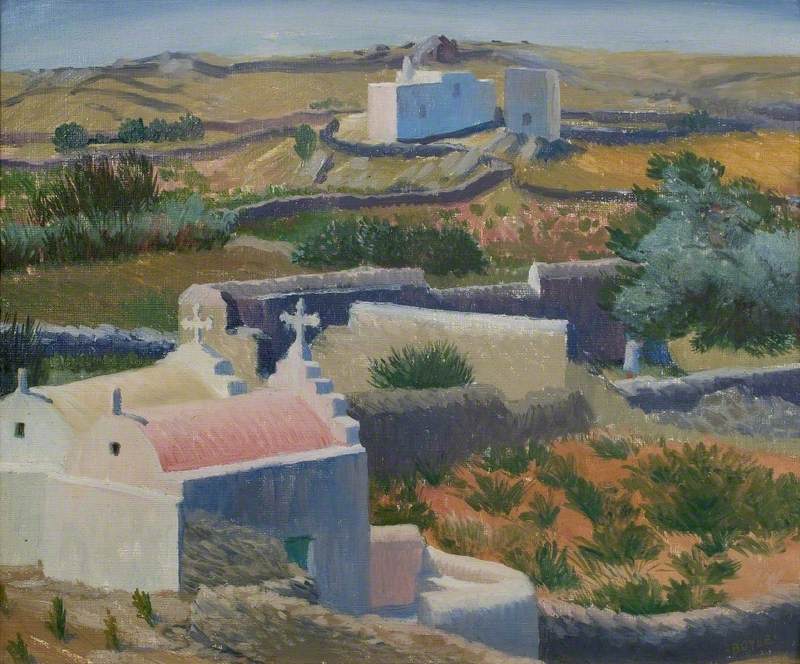 Alicia Boyle (1908–1997)
Alicia Boyle (1908–1997) -
 Gladys Maccabe (1918–2018)
Gladys Maccabe (1918–2018) -
 Georgina Moutray Kyle (1865–1950)
Georgina Moutray Kyle (1865–1950) -
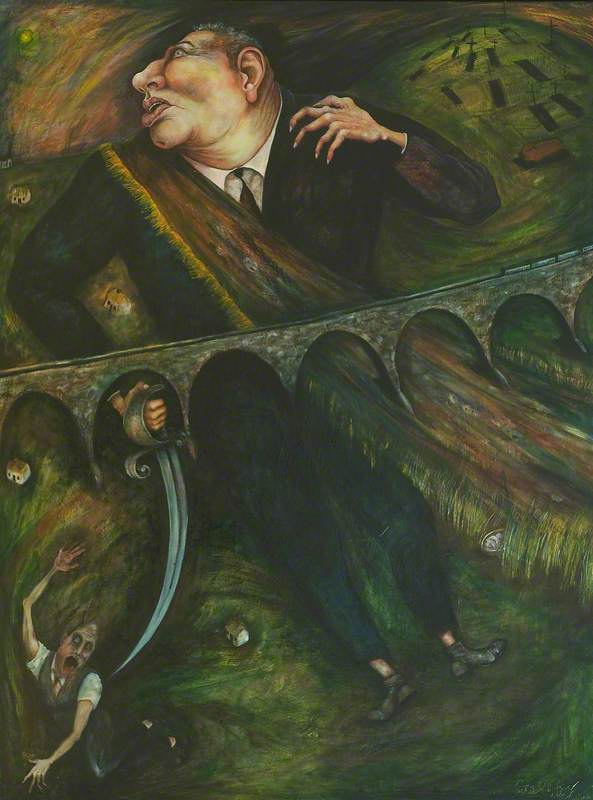 Rita Duffy (b.1959)
Rita Duffy (b.1959) -
 Sarah Cecilia Harrison (1863–1941)
Sarah Cecilia Harrison (1863–1941) -
 Evie Hone (1894–1955)
Evie Hone (1894–1955) -
 Carol Graham (b.1951)
Carol Graham (b.1951) -
 Margaret Clarke (1888–1961)
Margaret Clarke (1888–1961) -
 Mainie Jellett (1897–1944)
Mainie Jellett (1897–1944) -
 Sarah Henrietta Purser (1848–1943)
Sarah Henrietta Purser (1848–1943) - View all 11
